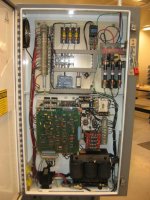Grigg
Hot Rolled
- Joined
- Jun 25, 2007
- Location
- Lexington, VA
Hello all,
Last month at work we got a new but used 10EE.
I sure could use some help and advice on what to check and take care of before putting it into service.
Here's some background on the machine:
Serial number 54218, 12-1994
5hp DC with large cabinet on back
Taper, coolant, DRO, Inch/Metric, electric leadscrew reverse.
Originally sold to Ford Motor Co, we're probably the second owner not counting the machinery dealer.
So far this is what I've done to it:
Shim it level on three points
Clean, clean, and clean.. but not done yet.
Change oil in headstock, DTE light McMaster #2158K14
Change oil in back gear box, DTE medium heavy McMaster #2158K15
Have way oil on hand for apron and tail stock, Vactra #2 McMaster #2158K21
Drain oil in feed gear box. still need to refill with DTE medium heavy
New gaskets for oil level window in feed gear box.
Change all 4 oil seals for levers and knobs on feed gear box, three CR #4985 and 1 CR#9876
Make tool and remove packing from C-D-E thread knob, need to replace it..
Replace nylon gear in inch/metric dials for compound, Monarch # 71357
Replace headstock cover/oil deflector gasket
Flatten the square thread/feed plate and replace gasket
New spindle drive belts Monarch # 68295
New feed belt Monarch # 19890
Replace main transformer mounts McMaster # 9376K16
Rewire from 460 volt to 230 volt, change jumpers for three different transformers, main fuses and coolant pump fuses, coolant overload relay, reconnect/rewire coolant pump for lower voltage
Check "Safety Circuits" following section 5.9 in manual
Drain, shovel out, and wash coolant sump.
Hook up power and test run.
It appears to be a very nice machine, but haven't cut anything with it yet.
On the to do list:
Replace packing for C-D-E thread knob, what should I use here?
Check and clean apron, ensure oil system works. Any tips, instructions, or where to start?
Replace all felt wipers.
Completely disassemble and clean taper attachment, replace several small missing parts at a minimum.
Fix feed gearbox oil leak into coolant sump, possibly leadscrew and or feed rod seals?
Troubleshoot and fix backgear shift lever interlock solenoid
Anything else I should check, adjust, fix, or replace??
Any tips or pointers?
Just got it rewired and running yesterday, can't wait get it done and put it to use.
Thanks,
Grigg
Last month at work we got a new but used 10EE.
I sure could use some help and advice on what to check and take care of before putting it into service.
Here's some background on the machine:
Serial number 54218, 12-1994
5hp DC with large cabinet on back
Taper, coolant, DRO, Inch/Metric, electric leadscrew reverse.
Originally sold to Ford Motor Co, we're probably the second owner not counting the machinery dealer.
So far this is what I've done to it:
Shim it level on three points
Clean, clean, and clean.. but not done yet.
Change oil in headstock, DTE light McMaster #2158K14
Change oil in back gear box, DTE medium heavy McMaster #2158K15
Have way oil on hand for apron and tail stock, Vactra #2 McMaster #2158K21
Drain oil in feed gear box. still need to refill with DTE medium heavy
New gaskets for oil level window in feed gear box.
Change all 4 oil seals for levers and knobs on feed gear box, three CR #4985 and 1 CR#9876
Make tool and remove packing from C-D-E thread knob, need to replace it..
Replace nylon gear in inch/metric dials for compound, Monarch # 71357
Replace headstock cover/oil deflector gasket
Flatten the square thread/feed plate and replace gasket
New spindle drive belts Monarch # 68295
New feed belt Monarch # 19890
Replace main transformer mounts McMaster # 9376K16
Rewire from 460 volt to 230 volt, change jumpers for three different transformers, main fuses and coolant pump fuses, coolant overload relay, reconnect/rewire coolant pump for lower voltage
Check "Safety Circuits" following section 5.9 in manual
Drain, shovel out, and wash coolant sump.
Hook up power and test run.
It appears to be a very nice machine, but haven't cut anything with it yet.
On the to do list:
Replace packing for C-D-E thread knob, what should I use here?
Check and clean apron, ensure oil system works. Any tips, instructions, or where to start?
Replace all felt wipers.
Completely disassemble and clean taper attachment, replace several small missing parts at a minimum.
Fix feed gearbox oil leak into coolant sump, possibly leadscrew and or feed rod seals?
Troubleshoot and fix backgear shift lever interlock solenoid
Anything else I should check, adjust, fix, or replace??
Any tips or pointers?
Just got it rewired and running yesterday, can't wait get it done and put it to use.
Thanks,
Grigg





